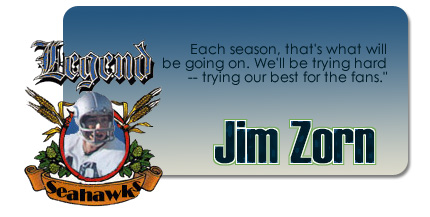
AFC West memories: Zig-zagging Zorn
Sports: Saturday, September 08, 2001
By Percy Allen
Seattle Times staff reporter
Editor's note: As the Seahawks play their final season in the AFC West, The Times looks back at some favorite memories in the division.
KIRKLAND — Today, the landscape of the NFL's AFC West division hardly differentiates between the franchises. Their similarities are far greater than their differences, which is a byproduct of a league where copyright laws are non-existent and player movement goes unchecked.
"Everybody looks the same," new Seahawks quarterbacks coach Jim Zorn lamented. "It used to be, the quarterbacks in this division gave each team their personalities. Kansas City might be different because they were a great running team, but Denver went to the Super Bowl with Craig Morton, who kind of epitomized that (1977) team.
"San Diego had Dan Fouts, and he would stand in the pocket and just bomb away. You'd wonder how many consecutive 400-yard games he'd get. ... (Oakland's) Ken Stabler bombed away, but it was different. They used two backs and two receivers and more of a vertical game."
And then there were the Seahawks.
They were considered outsiders when they joined the division in 1976, and Zorn, their quarterback, did very little to shy away from the tag with his unorthodox style of play.
"For us it was lots of bootleg," he said. "It was sprint-outs. We had the sprint draw with (running back) Sherman Smith. I would sprint out. I scrambled. With us, we had a very wide-open offense when it came to the AFC West.
"We were one of the first teams to put three receivers on the field and put people in motion. I remember Kansas City went the other way. They put three running backs on the field and tried to cram it down your throat. We had a different approach."
Zorn was the perfect leader of Seattle's imperfect offense. He was an undersized, mobile, left-handed free agent out of Cal Poly Pomona. The Dallas Cowboys cut him before he won a job with the expansion Seahawks and became the team's quarterback from 1976 to 1982.
The team had little talent, but Zorn and Hall of Fame receiver Steve Largent gave fans a reason to watch. He brought "Monday Night Football" to Seattle, converted fake field goals on national television and may have been the city's first big-league sports hero.
"Most of what we did was by design and scripted," Zorn said. "Sherman Smith lined up 7˝ yards (deep) and ran parallel to the line of scrimmage for three steps and then ran straight at the line of scrimmage. At the same time, I was sprinting out at a 45-degree angle, and I would either hand him the ball or I'd fake to him and keep on going outside.
"We perfected that mesh, and it was very difficult for a defense to know whether I was going to keep it or hand it off. And when we handed it off, it was a draw play. ... It was crazy."
Compared to the Hall of Fame careers of Fouts and Stabler, perhaps Zorn's approach was insane. But it was good enough for him to pass for 3,000 yards in three consecutive seasons (1978-80). He compiled a 40-60 record as a starter and finished second in the Seahawks record book behind Dave Krieg in yards (20,122), completions (1,593), attempts (2,992) and touchdown passes (107).
"I'm not sure you could teach some of what he did," Seahawks quarterback Matt Hasselbeck said jokingly.
But Zorn is certainly schooling Hasselbeck in the art of avoiding a sack. The newest Seahawks quarterback has recently shown scrambling skills that rival those of his coach.
"I might be a little bit of an unorthodox person and maybe as a player as well," Zorn said. "But as a coach, I try to deal with what's going to happen in the games.
"(Sometimes) you have to rely as much as you can on your fundamentals and you have to let your natural talents take over."
SPU's Zorn a novel stroke for unbeaten novice crew
By CLARE FARNSWORTH
SEATTLE POST-INTELLIGENCER REPORTER
Source: Seattle-PI
Thursday, May 9, 2002
Zorn has been a familiar name in the Seattle sports scene ever since a left-handed quarterback named Jim completed his first pass to Steve Largent in the Seahawks' inaugural season in 1976.The Zorn making a name for herself in the crew house at Seattle Pacific University is Sarah, the second of Jim and Joy Zorn's three daughters.
Sarah, an 18-year-old freshman, is the stroke in the Falcons' undefeated novice four crew that will look to cap its rowing season by winning the national title at the 64th annual Dad Vail Championships in Philadelphia this weekend.
As for Sarah's more famous father, now in his third year as Seahawks quarterback coach?
"We didn't know who her dad was," said Heidi Visser, another member of the novice four crew and one of Sarah Zorn's best friends.
"Shannon (Buehler, another crewmate) goes, 'My dad's really excited to meet Jim Zorn.'" Visser said. "I was like, 'Really? Who's Jim Zorn?'"
Visser, Buehler and the other members of the novice four crew -- Andi Martineau and coxswain Emily Thomas -- have since been introduced and indoctrinated.
"They're so supportive," Buehler said of Sarah's parents. "They have us over for dinner, and sometimes we go over and do laundry."
Added Sarah, "And he tries to coach us."
That's Jim Zorn. While he is a proud father, he also is a coach and always was a team player. He didn't want an article on the success of the novice four team to focus only on his daughter.
"The reason their boat is so fast is not so much because Sarah has all the power," he said. "The other girls are really stronger rowers than she is. They are better than she is. All three of them. Honestly.
"What Sarah has is the steady pace and she knows how to keep it -- and them -- going."
So does Falcons coach Keith Jefferson, a former SPU rower.
"I really like him," Zorn said. "One of the things he did was make them have two-a-day practices during their spring break. I like that. He knows what it takes to win, and he has asked them to sacrifice to help them win."
There has been a lot to smile about at SPU this spring, even beyond the 9-0 record achieved by the novice four.
The Falcons have qualified two other boats for the event on the Schuykill River tomorrow and Saturday that serves as the unofficial small-program national championship -- the unbeaten (5-0) varsity pair of Kimberly Tschetter and Trisha Sawatzky, and the once-beaten (5-1) varsity light four of Andrea Reichert, Julie Vieselmeyer, Elyse Canster, Erin Cox and cox Joanna Hodgkiss.
But the novice four has made the most waves.
Zorn and her teammates not only won the Western Intercollegiate Rowing Association championship in Sacramento on Sunday, their time of 7 minutes, 33 seconds was faster than the winning boat in the varsity four race -- 7:42 by Pacific Lutheran University.
"That," Jefferson said, shaking his head, "is very amazing."
How did this grab bag of a team get so fast so quickly?
It started last fall, when Zorn, Visser, Buehler and Martineau were just faces in a crowd of 30 hopefuls. Novice coach Josh Adam pared the field to16 before the final four was selected.
Zorn was placed at stroke because she had rowed for the Mount Baker Crew Club as a high school freshman in 1997.
"Sarah was the calming element back in the fall because she was the experienced one," Jefferson said. "But she also is a nervous competitor. So now what we're seeing is Shannon and Andi and Emily calming her down. Sarah is the pacesetter. So we need her calm."
Martineau, 21, a sophomore from Montana, took the bow seat -- despite being the strongest rower of the group -- because she had previous experience before back surgery last spring forced her out of the sport.
One doctor told Martineau she never would row again.
"Andi is one of our miracle children," Adam said.
The two and three seats -- called the engine room -- went to Visser, 19, from Wenatchee, and Buehler, 19, from Yakima.
"We like to say we have three engines," Buehler said, nodding toward Martineau.
As the cox, Thomas, 18, from Grants Pass, Ore., keeps the boat on line as well as everyone on the proper pace.
"Emily is our brain," Buehler said.
Jefferson and Adam have thrown some traditional requirements for seat selection overboard because, as Jefferson said, "A lot of it has to do with matching personalities."
It is a mix that is mastering something more difficult than it looks. While forming a tight bond -- in the boat, as well as on land -- these five have steadily lowered their times over a variety of 2,000-meter courses. From 7:58 and 8:10 in March, to 7:41 and 7:50 in April, to 7:33 on Sunday.
"We just shake our heads," Jefferson said. "When you look at this group compared to last year's novices, that group was bigger and athletically gifted.
"But these girls are faster. No. 1, they are tough as nails. No. 2, they get along great. To me, what they're doing is the bottom-line statement about teamwork. They row together, and they are of one mindset."
Despite their unblemished record, there is nothing glamorous about what they are doing. Practice takes place from 5-7 a.m. each day. The athletes raise much of their travel funds by holding car washes and working security at KeyArena. The annual budget for the program at SPU -- men and women -- is $4,000.
"That's what makes it so special. That's why I do this sport," Martineau said. "Because there's something special about waking up while the whole city of Seattle is asleep and coming out here in the middle of the night.
"It's like you're doing something devious."
Not to mention exceptionally well.


